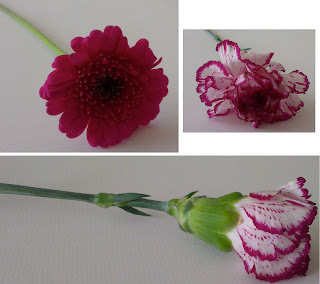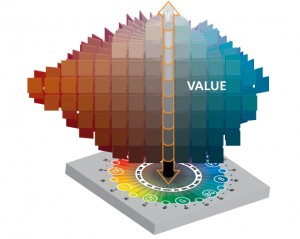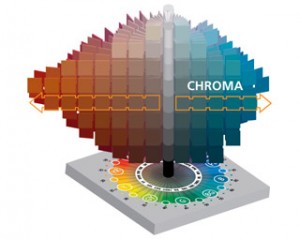Thursday 7th February 2013
I managed to get in contact with Anstey
Wallpaper Company to arrange a study visit to the factory. A lady Called
Sabrina replied to me with a date, which was 7th Feb 2013 would be
available to visit.
Thursday 7th Feb soon came round
and I was excited to go.
After driving to the factory in Loughborough.
Myself and Laura went to reception, filled in our visitors passes and waited
for Sabrina to come meet us. When Sabrina came to us she walked us to their
design studio and kindly offered us a drink while we discussed what we would
like out of the visit and she described what she would be able to show us. Also
she was asking us questions about our work that we were completing for our
final year. I mentioned to her that I had chosen to base my theme on the circus
with a floral twist and she loved that idea, also I mentioned that I was
struggling to find products by artist/designs who have completed work of this
theme. Sabrina said she remembered a company she had worked with that printed a
wallpaper of a beautiful circus theme and they were called Mokum. I looked this
up as soon as I got home and found the circus print wallpaper. This is the Wallpaper and it was designed by Catherine
Martin for Mokum.


Sabrina started by describing to us about
the design studio and how the designers and colourist there are not there to
design wallpaper but they play a crucial part in providing a service on
advising on contemporary and traditional design and colour trends. They offer
support regarding new product developments, e.g. substrates, inks and printing
techniques. The stylist may also act on the client’s behalf on any development
projects they wish to pursue. The team can also design a complete coordinating
package using their experience and knowledge of all the markets and the
client’s specific customer’s market sector.
They had the key equipment needed for
design and specialist software to develop designs from the initial scan to
working up of a source document, including manipulating the scale and repeat,
through technical separation and development of the colour palette.
There was another room attached to the
design studio, which was for hand sampling. The designers and colourist would
use this area to sample smaller scale samples of a clients desired design and
sample it with different techniques and colourways, inks, gloss, metalics and
pearl which can give a very wide variety of looks. Once the design is complete and the client is
satisfied with the look and style the final colourway will facilitate the
handover of collection to the production.
This machine was in the testing room and is where they use the print cylinders to test they are printing correctly and colour test.
Next Sabrina took us to the part of the
factory that is hand processed. We looked at the block printing area. This was the first known method of wallpaper
printing and takes a skilled person with a lot of dedication and experience to
complete. Technology today has failed to
produce any method that matches the tactility of hand block printing. Also in
recent years there have been limited developments whereby other more modern
materials such as linoleum, plastic and metal have become available, however
these material are more stable than wood, can twist, warp and crack.
The look of block printed papers are
however beautiful as we seen in the factory, but these take a long time to
produce being such a slow process and very cost effective.
I really can understand why it is such an expensive paper as when you see the quality of the print it is fantastic and the texture is beautiful.
Next we seen the block printed flocking,
this was introduced around the late 17th century, possibly inspired
by the flocked canvas hangings that were popular in Holland. An adhesive will
be applied to the paper that is very tacky and resemble white gloss paint; this
can be tinted using pigments to match the colour of flock being applied to add
to the dramatic look. Once the paper is coated in the glue and tinted if
necessary the length of wallpaper is drawn across a canvas bed where the flock
fibers are scattered, this is normally done by hand. Then wooden canes or
battens continuously beat the underside of the canvas bed to make the fibers
rub together and jump up and down creating static electricity enabling the
flock to stand on end creating the key look to the flock. The paper used for
flock is heavier because the flock is heavy and a standard paper weight
wouldn’t hold this weight and the paper has to withstand a lot of abuse during
the beating stage and thinner, lighter paper would tear easier. This method
takes around 2-3 days for the glue to dry for each flock colour.
We then went on to see the Pan (through)
printing. This method was introduced around the mid 1500’s as a means of evenly
colour-washing backgrounds for block printing onto. It is a process that has a
steel sheet that has holes drilled into it to create a thin strie stripe as the
paper is drawn by motor underneath it. Cutting an elongated channel creates a
wider stripe. The tray is continually filled with water-based inks that are
released through the sieve-like plate underneath the trough, which sits above
and almost touches the face of the paper. The paper is drawn through at a
controlled speed, ensuring an even and consistent distribution of the ink. Once
the paper is printed it is festooned onto a track suspended from the ceiling
and allowed to dry. The inks have to be fully cured before the paper can be
taken down and re rolled, ready to be put through the process again for the
next colour, or moved onto another process.
We then went onto see the Surface Print
machine. This method was introduced around 1839. It continued as the only
mechanised means by which to print wallpaper for the next 100 years. It was
responsible for making wallpaper available for the masses and it’s immediate
success marginalised block printing.
It is the oldest of the mechanised
processes and is predecessor to the relief printing Flexo machine. It has a
large drum cylinder with print stations spaced around the circumference. The
print cylinders are made of a very hard ‘ceramic’ type rubber and the area that
you don’t want printing is cut out, leaving the printing surface ‘proud’ on the
cylinder. The inks used are water based and transferred via a rotating woolen
or felt blanket. The blanket is soaked at one end whilst the other is touching
the back of the print cylinder. As the conveyor belt type blanket rotates it
picks up the ink from the tray and delivers it onto the back of the print
cylinder; the ink is then impressed directly onto the paper as it is rotated.
The amount of ink transferred onto the cylinder is determined by the absorbency
of the blanket. The more porous the blanket, the more ink, the harder the
blanket, the less ink. Also as the ink is water-based it is still wet as it
reaches the next part of the print station therefore the application of wet ink
applied over wet ink creates an effect where the colours lightly bleed into one
another, giving a very soft visual finish.
We then went onto see the Flat-Bed Screen
Printing (Silk Screen Printing)
This method was invented in the early to
mid 1940’s, later being introduced in Britain from America in the late 40’s.
The screen is a rectangular frame with a fine polyester nylon woven mesh
stretched across it. The screen needs coating photosensitive polymer, the
stencil of the design is then placed flat onto the mesh before the screen is
photo-exposed. The exposure hardens the
polymer into an impenetrable lacquer. The area that was masked by the stencil
remains fluid and once the screen is washed the stenciled area comes off becoming
open mesh. This then allows printing inks through. The screen is placed face
down onto a long flat table that has a length of wallpaper laid tight against
it from one end to the other. It can print up to 9 wallpaper rolls at a
time. Thick water-based inks are applied
to the back of the screen and are drawn across the mesh using a rubber squeegee
forcing the ink through the open areas on the mesh in the shape of the design.
Once the colour is laid the screen is lifted and moved along the next position,
where the process is repeated. It’s important that the inks are allowed to dry
fully before any subsequent screens are placed on top. This prevents the screen
potentially picking up previous colours laid down and also smudging the design
on the wallpaper. To try and prevent this it is normal that they print every
alternate screen, before going back and filling in the gaps when the inks have
dried. It is a very labour intensive and demands constant vigilance making it
an expensive process aimed towards the top end of the market.

Here you can see how many screen there are
These are the hand screen print tables.
This machine above is for screen printing but whereas on the hand screen printing table you move the screen it's self along, with this machine the screen stays stabilised and the wallpaper is attached to what is like a conveyor belt and that moves the paper along.
Next we seen the Rotary Screen Printing
method which was introduced in the early 1950’s. The machine would have an
in-line configuration with upwards of seven or eight print stations available,
each printing one colour. The cylindrical printing screen itself is a very fine
‘honey combed’ type mesh. The screen is produced by photochemical means, in
that a photopolymer coating is applied to the surface of the screen before
photographic exposure causes it to harden on the mesh. Therefore to create the
design it is just a question of ‘masking off’ the mesh with a stencil in the
desired shape. The areas of the mesh that have been hardened will not allow the
ink through. Therefore the ink is squeezed, under pressure from the inside of the
cylinder mesh. The inks used in this process are quite opaque, and rich colours
are achievable. It is important that the ink is fully dry before the paper
reaches the next print station. Hot air dryers between each print station do
this. This method does have the benefit of being cheaper, due to being a
continuous print process.
Next we saw the Flexographic Printing
machine. It was introduced into Britain in the early 1960’s. The print stations
are evenly spread around the outside of a large cylinder drum that carries the
paper face out around it. The ink is transferred from the ink tray to the print
roller via an ‘anilux’ roller, the purpose of which is to both even out and
determine how much ink is transferred onto the cylinder. A deeply cut anilux
roller will transfer more ink than a shallow cut one. As the print cylinder
rotates the ink is transferred directly onto the paper as it is squeezed
against the large cylinder drum. This process will readily accept the use of
either water-based or solvent-based inks, although like gravure, solvent based
inks are considered more stable for print processes, also more environmentally
friendly as the factory collects the fumes from the solvent and then burns them
to enable this to heat the factory. Flexo printing is very versatile; it is
used extensively in the packaging industry, for printing such things as plastic
bags, crisp packets, cardboard boxes, etc.

The Gravure Printing machine was next, it
was introduced around 1954 as a development of photochemically etching a design
onto a copper plate that was then wrapped around a base. Once engraved the
cylinder is electroplated with a thin layer of chrome to create a heard wearing
coating for durability. This is necessary as copper is very soft and if it was
not protected in some way it would be very easily damaged during the printing
process. The benefit of using a gravure printing machine is the ability to
print fine tonal work and graduation of colour using a single cylinder. This
graduation of colour, governed by the depth and width of each individual cell,
can be from a solid colour through to anything as subtle as 20% tint. Combine this with the fact that a typical
gravure machine may have 8 or more cylinder stations, it is easy to appreciate
that the perceived amount of colour achievable is extensive.
Here the gentleman in the picture is cleaning the print cylinders in the machine to remove the last colour ink used in preparation to print with a different colour. It is very important they remove all traces of the ink to avoid smudges on the next print.
We then finally went on to see the Heat
Embossing Printed Vinyls machine.
The purpose of the machine is to convert a
smooth plastic wall covering into a wall covering that has a third dimension.
The start of the print process is with a smooth layer of PVC laid onto a
backing layer, normally paper. Whilst at this stage the solvent based ink
pigments adhere well to the PVC, it isn’t until the whole sheet has been heat
embossed does it become ‘fused’ effectively making the inks a part of the
coating itself. Sabrina mentioned that this is a very expensive process also
and for a cylinder to have the embossed pattern put on can cost 10,000, which
as you can imagine doesn’t get many small companies or Artist/Designers using
this method.
We also looked at the Digital mimaki
printer which are now printing a wallpaper of like the triple width of a
standard one which looks really good. Also she showed us another printer that
was completing colour tests to ensure the correct colours are in use for the
wallpaper. Sabrina also mentioned how they had been delivered a brand new
printer that could print to the widest width but print 3 of these at the same
time, which is amazing.
This image above shows the mixing room where they mix the inks to achieve the correct colour needed for the client.
This is how the wallpaper looks after being printed on the machines before taken to the last stage to be checked for defects, cut into 10 metre lengths and packaged by inserting the brand label and wrapped in cellophane for sale.
The image above shows the machine that puts the brand label onto the wallpaper rolls and then wrapped in cellophane.
I have really enjoyed this visit and have
benefited greatly as I now have an idea how the industry works and also have
the answers to things that I wondered. I had conversations with Sabrina about
my final designs and mentioned that I would like to have wallpaper printed for
my final product and I asked if it would be possible that they could maybe be
the supplier of this, which she said yes and that she or another member of
staff would help me through the stages of deciding what print techniques will
be best to be used, which is fantastic news. Also if I have any questions she
said to just email her. I also asked about work placements, Sabrina said that
they do accept work placements but only 1 or 2 a year and the process of this
is like applying for a job, sending a C.V, then interview. I also realised that
work placements are extremely important as one girl thay took on as work
placement showed herself whilst there and they offered her a job at the end of
her degree. So it just shows that if you prove yourself good things can happen
from it. I am very satisfied with what I
have learnt and I intend to apply for a work placement once I have updated my
C.V.























































